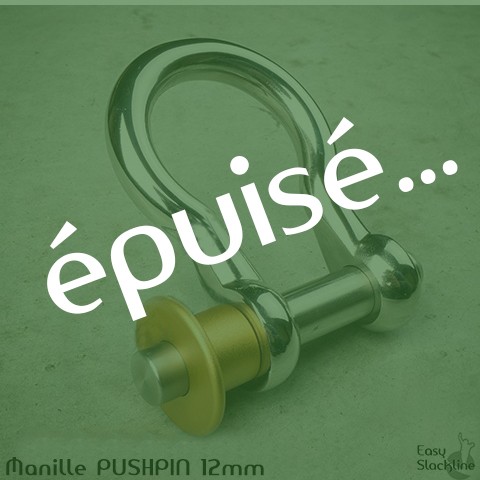From Monday to Friday 09:00am - 18:00pm
The goal of highlining is to walk on a slackline in the void, secured by a harness and a lifeline called a backup.
--> More details on the practice of highlining <--
For more details on this category and these products, click on the "Learn More" link below.
Highline There are 13 products.
-
Highline webbing
 All our slacklines are made, cut and sewn in France
All our slacklines are made, cut and sewn in France 
You will find here thin, tubular or flat slacklines of different materials.
--> More details on the practice of highlining <--
For more details, click on "Learn More" below.
-
Highline gear
All the accessories to the unit or in pack for highlining. If you already have a slackline, this is where you will find the single elements.
--> More details on the practice of highlining <--
For more details on this category and these products, click on the "Learn More" link below.
-
-
-
Vortex 2.0 - highline leashring Vortex 2.0 - highline leashring
23,96€ 29,95€ -20%Flat aluminum leashring to optimize friction on the slackline! 80mm inside diameter to allow connections and bananas to pass easily. Flat aluminum leashring to optimize friction on the slackline! 80mm...
Out of stock -
Tubular slackline RVD Tubular slackline RVD
1,30€ 2,00€ -35%The reference among tubular slackline webbings, stretchy and comfy under the feet. Smooth, with soft edges. A must have for swelling (light bounces) and surfing ! The reference among tubular slackline webbings, stretchy and comfy...
Out of stock -
Tubular slackline Reggae Tubular slackline Reggae
2,00€The reference among tubular slackline webbings, stretchy and comfy under the feet. Smooth, with soft edges. A must have for swelling (light bounces) and surfing ! The reference among tubular slackline webbings, stretchy and comfy...
Out of stock -
Flat slackline ShaQ - round edges Flat slackline ShaQ - round edges
1,43€ 2,20€ -35%Super soft with ultra round edges, the ShaQ is perfect for those looking for comfort ! Super soft with ultra round edges, the ShaQ is perfect for those...
Out of stock -
Flat high tech slackline MoonWalk - Hybride Flat high tech slackline MoonWalk - Hybride
3,20€Ultra light and easy to tighten thanks to her low stretch. The webbing conceived for ultra long lines or for an ultra light kit. All our slackline webbings are made and sewn in France Ultra light and easy to tighten thanks to her low stretch. The...
Out of stock -
Flat slackline Slodki - round edges Flat slackline Slodki - round edges
2,20€Super soft with ultra round edges, the Slodki is perfect for those looking for comfort ! Super soft with ultra round edges, the Slodki is perfect for those...
Out of stock -
Diamond Lock - Linelock pour manille Diamond Lock - Linelock pour manille
14,37€ 16,90€ -15%Webbing locker suitable for shackles, for all 2,5cm webbings until 70m long Webbing locker suitable for shackles, for all 2,5cm webbings until...
Out of stock -
Dynamometer LineScale 3.0 Dynamometer LineScale 3.0
1 185,99€The dynamometer for slackline ! To know the tension in real time !With bluetooth connection and PPE certification. The dynamometer for slackline ! To know the tension in real time...
Out of stock -
-
PushPin 12mm shackles PushPin 12mm shackles
9,95€ 19,90€ -50%Reduced price!12mm Pushpin steel shackle - a must have - very user-friendly ! 12mm Pushpin steel shackle - a must have - very user-friendly !
Out of stock -
What is highlining ?
Aerial variation of the slackline, the highline is the queen discipline. Its goal is to walk in the void on a slackline set to several tens, even hundreds of meters high, secured by a harness. Strong sensations guaranteed!
Often seen on television or in video, the highline leaves no one indifferent! Very spectacular, the discipline is not without risk. The highliner (the one who is on the slackline) is attached to the slackline and to the lifeline by a harness, so it is important to install correctly all the material to ensure his safety and let him enjoy the sensations!
You need to acquire special skills to install a highline - for example through a highline course or a slackline association.
A very different installation from other disciplines:
In highline, in addition to the webbing on which the highliner evolves (mainline), it is necessary to install a life line to secure the installation (backup).
The backup is installed under the mainline, independently. They are only connected by tape so that the highliner doesn't get his feet tangled in them during the crossing or a fall. The highliner is attached to both lines at the same time by a ring and a harness. This way, if a problem occurs on the mainline (breakage of the webbing), the highliner is caught and secured by the backup (life line).
The simplified diagram below clearly illustrates the principle of installing a highline. This is an example, it cannot be considered as THE rule to follow to secure yourself. Many other factors come into play to ensure the safety of the highliner (minimum height to be respected according to the length, attachment points, weather, etc.).

source : wikipedia
Which highline webbing should I choose?
There are different types of slackline webbings:
Tubular slackline webbing, playful (swell, wide and soft bounces), they allow for elasticity even over short distances. They are more flexible, light and compact than the flat ones. They have a resistance around 22kN.
- The RVD and the REGGAE (only the color will differ between them, and there it is up to you to choose)
- If you are looking for elasticity, lightness and compactness (to carry it easily), then I recommend tubular slacklines.
Flat slackline webbing, less elastic and easier to tighten. They are also very comfortable for bare feet because they have round edges. They are more robust than tubular ones. They have a strength of around 30kN.
- The Slodki, the Shaq (only the color will differ between them, and there it's up to you)
- If you are looking for a slackline that is easy to stretch (because it is less elastic) and very comfortable underfoot, then I recommend flat slacklines.
High-tech slacklines, like the Moonwalk. It is ultra light, very static and very resistant, made of 50% polyester and 50% dyneema (or HMPE). The interest of the Moonwalk is to set very very long (100m and much more), or to have a setup as light and compact as possible. It is a slackline that has been used for several world records in longline and highline and is highly regarded by the expert slackline community.
- If you're looking for a slackline for highlining to stretch very long, or to have a minimum weight/volume in your backpack, then go for it.
Characteristics of the slacklines and resistance
On the picture of each slackline you will find pictograms to summarize the performance of each slackline. So you can compare them at a glance!

How are the slacklines tested at Easy Slackline?
Blog : tests et résistances des slacklines
Safety and highline
All the slackline webbings and seams that I offer can be used in highline as well as "mainline". It is important to check the compatibility of the material's characteristics with your practice and your needs.
For the "backup", I strictly recommend PPE (personal protective equipment). The slackline material, except express mention, is not approved EPI. And are not intended to insure you and to serve as a life line.
Click on the link for more information on highline gear and webbings and to start highlining.
Any other questions?
Then I invite you to consult the FAQ where there are details of many questions that everyone can ask about slackline and Easy Slackline!
Or call me directly : 07 67 14 87 18























































